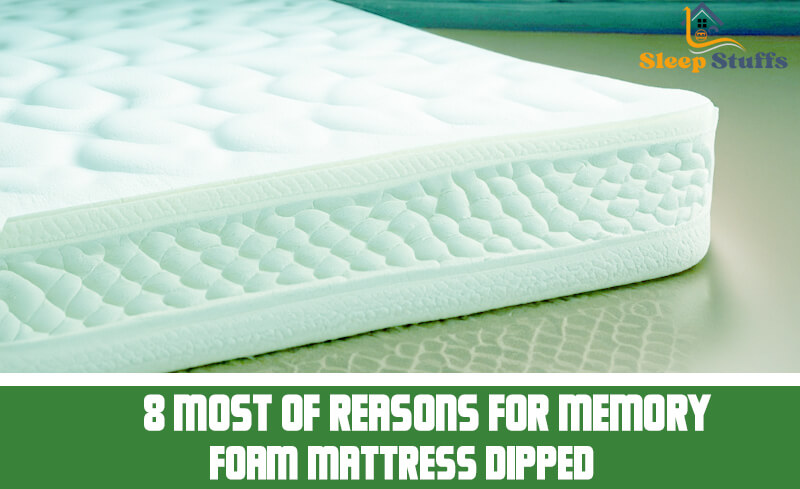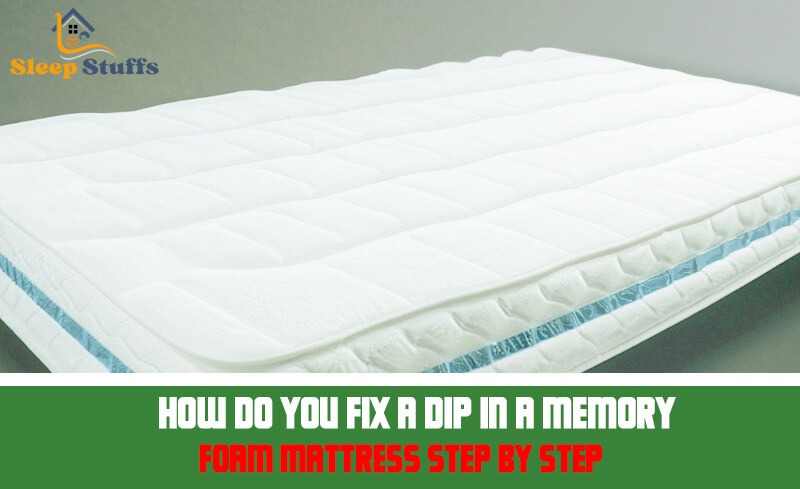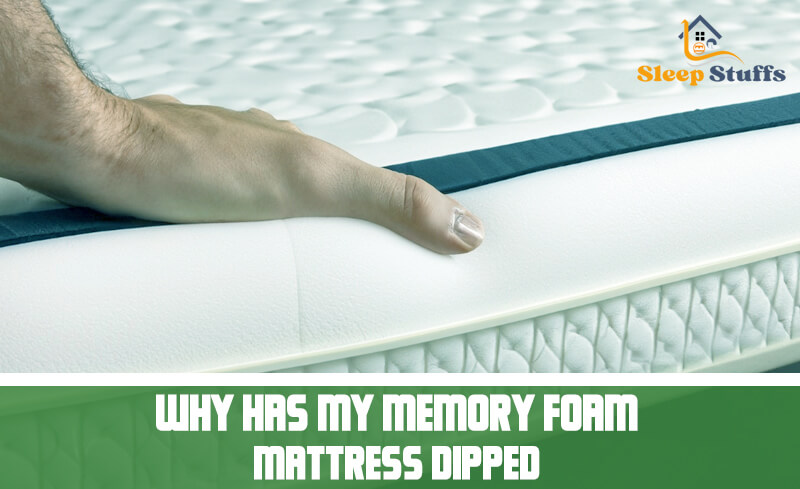Is it hard to get out of bed in the morning? If so, then your memory foam mattress may be dipping. A dipping mattress can be uncomfortable for you during sleep.
In this article, we’ll Discuss the potential causes of these dips and provide practical steps to help you address the problem.
Generally, Dipping happens when the edges or corners of your mattress become concave. Memory foam beds are for well. They support and adapt to the body.
Over time, regular use, the way the weight is distributed, and the quality of the materials can cause the surface to get dents. Due to this problem, you can wake up frequently at night.
Don’t worry. I’m here to describe the possible reasons why memory foam mattresses dipped. So, without further due, let’s get started.
8 Most Of Reasons for Memory Foam Mattress Dipped
Before we jump into the solutions, let’s figure out Why My Memory Foam Mattress Dipped. Here are some of the most common reasons why a mattress may dip

1. Improper Support
The first and foremost reason is improper support. A good mattress should be placed on a solid, flat base. It supports the weight of your body evenly. If your bed does not have a proper base, it can cause your mattress to dip or sag.
The wrong thing that you can do is placed it on a spring base. It will cause more pressure on some specific areas. It is a sign of improper support. Due to this, your mattress will break down earlier.
2. Bodyweight
Before buying a mattress, it is important to know its weight limit. If you are too heavy for your mattress, it will sink easily. This is because it gets damaged due to the lack of support from a firm base. Got it?
Let’s clear this matter: If your weight is not properly distributed, it is more likely to cause sagging. Suppose, your weight is 80 KG or more. You should select a mattress that is capable of this mattress. If not, then you should not purchase that mattress.
So, due to excessive body weight, your mattress can sag and dip.
3. Poor Quality of Mattress
The quality of your mattress is one of the most important factors. It can affect its durability. If you have bought a low-quality mattress, then you should expect it to sag or dip sooner than expected.
It’s better if you choose a mattress that has been certified. Moreover, the mattress should have a good warranty period. This will help you to get your money back if the mattress doesn’t work as expected.
Ask your seller for a warranty card and check the certified issues.
4. Firmness Level
Another reason for dipping is the “firmness level”. You may have noticed that if you press your mattress with a hand, it will sink. This is because of the firmness of a mattress.
So, It depends on its material, quality, and body weight. A crib mattress becomes sagging or dipping when the firmness level is not suitable for you. When I was a bachelor, I bought a very soft mattress. But, It didn’t last much longer due to the firmness level.
So, go with the medium-firm mattress. It suits your body weight. Never choose a mattress that is too soft or too hard.
5. Age of a mattress
After a mattress’s life cycle, it may start to dip in the middle. This is a natural process. It can’t avoid. At least, you can slow it down. Manufacturers offer a warranty of 10 years of lifetime. But, it doesn’t mean that your mattress will last for the same period.
Some low-quality mattresses can dip within 1-2 years. So, if your mattress is more than 6 years old, then you should consider replacing it. It’s not a good idea to invest to reshape. I don’t think it’s worth it. It depends on your personal preference.
Take your time, and do research before investing in a new mattress . Being overwhelmed is not a better practice always.
6. Sleeping Position
The way you sleep can affect how quickly a mattress dips. Different sleeper positions can cause different parts of the mattress.
For example:
For a side sleeper, their weight will continuously press down in one spot. It causes the mattress to dip. Besides, the mattress can’t provide the support they need. Thus, it can’t maintain proper spinal alignment.
So, what about the stomach sleeper? For them, the mattress can’t provide proper support to their lower back and neck. As a result, it causes them to sink into the mattress.
So, depending on the sleeping position dipping occurs. You can change your habit or choose the right mattress that suits your sleeping position.
7. High Humidity and Excess
Heat: Did you ever hear about this reason? Yes, it is a possible reason. Humidity and excess heat can be one of the reasons for your mattress dip. High humidity and extreme temperature can cause sag or dip.
When you sweat during your sleep, the mattress is likely to absorb it. This will cause dipping. Also, when you don’t open windows for air circulation, humidity can build up. It will be not over.
To avoid this, try to keep your bedroom cool. In addition, create decent air circulation in the room. Never forget to open the window or use a fan or air conditioner every day.
8. Improper Mattress Cleaning
Mattresses are one of the most neglected items in our home. They’re often left untouched for months. Due to this, dust particles and other dirt settle on the mattress. Thus, it makes it more vulnerable to sagging.
So, what’s the solution? You should be mattress cleaning your mattress every 6-12 months. To do this you can use a vacuum cleaner or steam cleaner. Do you have kids? You clean it every 3-6 months.
How to Fix a Dip in a Memory Foam Mattress (Step by Step)
Let’s tackle that annoying dip in your memory foam mattress together! We have a toolkit of practical steps to help restore your mattress’s comfort and evenness. Prepare to bid farewell those troublesome dips and welcome a more peaceful slumber. How do you fix a dip in a memory foam mattress Step by Step

Step 1: Rotate the Mattress
Start simple by rotating your mattress 180 degrees. I can help distribute the pressure and wear more. Think of it like turning a pancake to ensure both sides cook right.
Step 2: Flip the Mattress Upside Down
If your mattress design allows for it, try flipping it over. Not all memory foam beds are made to be turned over. So check with the company that created it before you try.
Step 3: Use a Mattress Topper
Adding a mattress topper can be a game-changer. A good-quality topper can provide extra cushioning and support. It helps to reduce the sensation of the dip.
Step 4: Reposition the Mattress Layers
If your mattress has removable layers, consider repositioning them. Sometimes, a simple change can affect the mattress’s feel and evenness.
Step 5: Temperature Regulation
Memory foam mattresses can be sensitive to temperature changes. Keeping the room temperature steady keeps the foam from getting too soft and causing dips.
Step 6: Change Sleeping Positions
We all have a favorite way to sleep, but changing it up can help you spread your weight out more. It can prevent excessive wear on specific areas of the mattress.
Step 7: Consult the Manufacturer
If you’ve tried the previous steps and the dip persists. It’s time to reach out to the experts – the mattress manufacturer. They might offer specific insights or recommendations based on your mattress model.
How to get dip out of memory foam mattress
You can do a few things to fix a dip in your memory foam mattress. Start by rotating the mattress 180 degrees to distribute the wear.
If your mattress design allows, consider flipping it upside down.
By adding a mattress cover, you can get more cushioning and support, which will make the dip feel less noticeable.
Repositioning the mattress layers or adjusting your sleep position can also help. Temperature regulation is crucial, as extreme conditions can impact the foam’s structure. If the dip doesn’t go away, talk to the mattress maker to find out what to do.
You’re taking proactive measures to restore your mattresses by following these steps. Evenness and comfort ensure a more peaceful and restful sleep experience.
Frequently Answer Questions(FAQs)
How do I know if my memory foam mattress is worn out?
Your memory foam mattress is worn out if it no longer provides adequate support for your body. A worn-out mattress will leave you feeling sore. Moreover, it can achy in the morning or even throughout the day. Symptoms are Sagging, Ripping, Holes, etc.
How often should memory foam be replaced?
You should replace it every 6 to 7 years. Due to the fact that it is made of foam. It does not last as long as other kinds of mattresses. However, you should replace your memory foam mattress if there are any signs of wear. Such as dips and sagging on the surface.
How can I make my memory foam hard again?
Actually, it’s really hard. After a few years of use, it will become softer and less supportive. This is because the memory foam will break down over time. To make your mattress hard again, you can place a board under the mattress to lift it up off of the box springs.
What is the lifespan of a memory foam mattress?
Generally, the lifespan of a memory foam mattress is about 10 years. However, the exact lifespan depends on several factors. The most important one is the quality of memory foam. If the high-quality product is used for foam mattresses. It’s still possible for it to wear out within a few years. It can cause improper use or care.
Final word
In conclusion, you should now be able to deal with and fix the dip in your memory foam mattress.
With the comprehensive step-by-step guide provided. you have a toolkit to counter this common issue and restore your mattress’s evenness. Remember, the formation of dips can be attributed to factors such as wear and tear over time or uneven usage.
After several years, it’s common to sag or dips a mattress. This occurs for many reasons. You have almost known the 8 reasons. So, it’s not possible to pin down the exact cause without inspecting the mattress yourself. To avoid this dip, you should take care always.
You should take steps ASAP if you see dipping or sagging symptoms. Rotate the mattress every 1-3 months. Furthermore, use a mattress protector to help extend its life. If not, then you may have to replace it.
So, guys, I think you can know here about Why has my memory foam mattress dipped? You can take a little care and maintenance that can help from dipping. Don’t hesitate to replace it if necessary. Thank you.


2 thoughts on “Why Has My Memory Foam Mattress Dipped?”